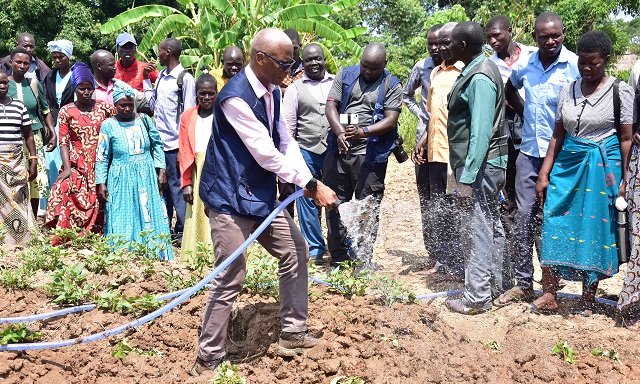
Katakwi, Uganda | Patricia Akankwatsa | A groundbreaking irrigation project, spearheaded by the Food and Agriculture Organization of the United Nations (FAO), in partnership with the Norwegian government and the Global Environment Facility (GEF), is poised to reshape agricultural landscapes and boost food security in Teso sub-region.
By introducing state-of-the-art irrigation systems, the initiative aims to dismantle the shackles of rain-fed agriculture, a practice that has historically rendered the region vulnerable to the whims of the weather.
Traditionally reliant on unpredictable rainfall patterns, Teso farmers have grappled with the spectre of crop failures, leading to food shortages and economic instability. The new irrigation infrastructure promises to be a game-changer, providing a lifeline of water to crops throughout the year. This transformative shift is anticipated to propel crop yields to unprecedented heights, doubling or even tripling production of staples like maize, sorghum, and beans.
While speaking at the launch of the three irrigation systems and a valley tank in the districts of Katakwi and Amolatar, the FAO country representative, Dr. Antonio Querido said that this project is more than just an irrigation initiative’s a catalyst for sustainable development.
“Given the increasing unpredictability of the climate, this irrigation system offers farmers the opportunity to establish year-round crop production. Ensuring a consistent water supply at the field level facilitates expanded cultivation, crop diversification, and enhanced livelihoods,”
Dr. Antonio emphasized that irrigation is indispensable for addressing food shortages and increasing agricultural yields both domestically and regionally.
The ripple effects of increased agricultural output extend far beyond the farm. A surge in food production is expected to stabilize, if not decrease, local food prices, offering much-needed relief to consumers.
Beyond its immediate impact on food security, the irrigation project stands as a defence against the escalating threats of climate change.
By decoupling agriculture from the vagaries of rainfall, farmers become more resilient to the ravages of droughts and floods, which have become increasingly frequent and severe in recent years.
Betty Agweng one of the farmers from Amolatar said that this project will help them throughout the year because it is sustainable.
“We have two seasons but sometimes they are both not favourable. It is sometimes either too dry or flooded but with the water tanks, even with the flooding, water will be collected in one place and we will be able to use it, adding that; it will help also us during dry spells. We shall continue producing especially the vegetables which will earn us a lot of income as well as food security,”
She added that this will ultimately improve their livelihoods overall.
“Farming is a business to us and our only survival. When there is no food, there is hunger which also affects our children and they are not able to attend school which ultimately affects the education system. Everything to us is connected to farming. We are hopeful that this irrigation system will change everything,”
The initiative promotes climate-smart agricultural practices to maximize the project's benefits while minimizing its environmental footprint. These include water-efficient technologies and agroforestry systems that optimize water use and enhance soil fertility.
Each system is capable of delivering a flow rate of 10,000 litres per hour, with storage capacity provided by a 30,000-liter underground reservoir and two 10,000-liter above-ground tanks.
About the irrigation systems
Amolatar irrigation system: The Amolatar Aleble irrigation system is a hydrant system with a pipe network covering 20 acres with the potential of covering more farmland through mobile hose pipes. The irrigation practice is semi-manual, especially through the use of a drag hose or collecting water in a container and irrigating manually using a watering can for small fields.
The system is comprised of a solar water pumping unit with an attendant controller and PV-array structure, overhead storage tanks, a pipeline network, and hydrants.
Magoro irrigation system: The Magoro irrigation system is a hydrant system with a pipe network covering 30 acres but can be extended to cover more acreage by deploying mobile hose pipes. The irrigation practice is semi-manual, especially through the use of a drag hose or collecting water in a container and irrigating manually using a watering can for small fields.
The system is comprised of a solar water pumping unit with an attendant controller and PV-array structure, overhead storage tanks, a pipeline network, and hydrants.
Toroma Valley Tank: The new and improved valley tank can support about 1,500 cows and 1,000 small luminants through the drought period of December to March.
 The Independent Uganda: You get the Truth we Pay the Price
The Independent Uganda: You get the Truth we Pay the Price



